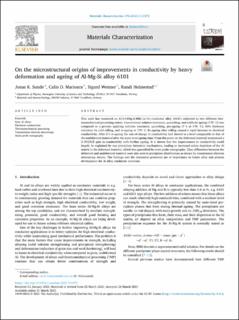| dc.contributor.author | Sunde, Jonas Kristoffer | |
| dc.contributor.author | Marioara, Calin Daniel | |
| dc.contributor.author | Wenner, Sigurd | |
| dc.contributor.author | Holmestad, Randi | |
| dc.date.accessioned | 2022-10-11T08:10:26Z | |
| dc.date.available | 2022-10-11T08:10:26Z | |
| dc.date.created | 2021-04-06T22:04:03Z | |
| dc.date.issued | 2021 | |
| dc.identifier.citation | Materials Characterization. 2021, 176, 1-11. | en_US |
| dc.identifier.issn | 1044-5803 | |
| dc.identifier.uri | https://hdl.handle.net/11250/3025283 | |
| dc.description.abstract | This work has examined an Al-0.54Mg-0.38Si (at.%) conductor alloy (6101) subjected to two different thermomechanical processing routes. Conventional solution treatment, quenching, and artificial ageing (170 °C) was compared to a process applying solution treatment, quenching, pre-ageing (7 h at 170 °C), 50% thickness reduction by cold-rolling, and re-ageing at 170 °C. Re-ageing after rolling caused a rapid increase in electrical conductivity. After 2 h re-ageing the rate of change in conductivity had slowed to a level comparable to that of the undeformed material after the same total ageing time. From this point on the deformed material maintained a 2–3%IACS gain in conductivity with further ageing. It is shown that the improvement in conductivity could largely be explained by two precipitate formation mechanisms, leading to increased solute depletion of the Al matrix in the deformed material, which was quantified by atom probe tomography. Clear differences between the deformed and undeformed material were also seen in precipitate distributions as shown by transmission electron microscopy results. The findings and the discussion presented are of importance to future alloy and process development for Al alloy conductor materials. | en_US |
| dc.language.iso | eng | en_US |
| dc.publisher | Elsevier | en_US |
| dc.rights | Navngivelse 4.0 Internasjonal | * |
| dc.rights.uri | http://creativecommons.org/licenses/by/4.0/deed.no | * |
| dc.title | On the microstructural origins of improvements in conductivity by heavy deformation and ageing of Al-Mg-Si alloy 6101 | en_US |
| dc.type | Peer reviewed | en_US |
| dc.type | Journal article | en_US |
| dc.description.version | publishedVersion | en_US |
| dc.rights.holder | © 2021 The Author(s). Published by Elsevier Inc | en_US |
| dc.source.pagenumber | 11 | en_US |
| dc.source.volume | 176 | en_US |
| dc.source.journal | Materials Characterization | en_US |
| dc.identifier.doi | 10.1016/j.matchar.2021.111073 | |
| dc.identifier.cristin | 1902553 | |
| dc.relation.project | Norges forskningsråd: 247783 | en_US |
| dc.relation.project | Norges forskningsråd: 197405 | en_US |
| dc.relation.project | Norges forskningsråd: 197411 | en_US |
| dc.source.articlenumber | 111073 | en_US |
| cristin.ispublished | true | |
| cristin.fulltext | original | |
| cristin.qualitycode | 1 | |

